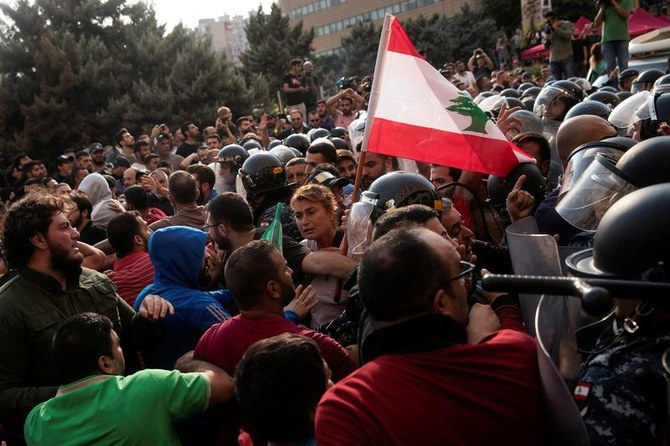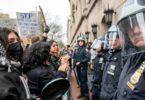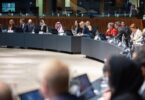Nadim Shehadi
There is an “end of time” mood in Lebanon. Beirut feels like a combination of the last days of Byzantium, with all the internal bickering, together with the fall of Rome, with a vibrant nightlife and fully booked restaurants. At the same time, the country’s institutions are crumbling, one after the other.
The process is driven by a series of default options with the inability to make decisions, except those taken by default. The failure once again to elect a president this week is a perfect example of how the system is blocked and being held hostage until it complies.
It also means that the country is heading toward more paralysis and further erosion of institutions. The mandate of the governor of the central bank ends in July, and that of the commander of the army a few months later. Neither of them can have their terms renewed, nor can an appointment currently be made to replace them.
Lebanon is slowly disintegrating, with no president, a paralyzed parliament and a caretaker government with limited powers. Soon it might also be without a functioning judiciary, army or banking system.
It is the perfect crime, because nobody is responsible. The inability to take any action means everything happens by default and everyone accuses everyone else. In the meantime, the saga of the presidential election, and the scandals surrounding the governor of the central bank, keep the country busy and are a distraction from the main issue, which is a combination of inertia and atrophy resulting from blocking the system at every stage.
The fact is that Lebanon desperately needs a president but Hezbollah does not. The current state of the country is ideal for Hezbollah’s operations. With the collapse of the banking sector and the financial meltdown, Lebanon is now largely a cash economy made sustainable, to a certain extent, by a regular inflow of dollars from the Lebanese diaspora to support their families. The whole economy, and its global connections, is being transformed into a giant money-laundering machine. The bickering brings the country down, while the festivities keep it going.
The biggest question about the election of a president is no longer who will win. It is how long the void will remain and will there be a new president at all. The office has been vacant for long periods before.
If there is a pattern to observe in recent years, it is one of increasing periods of political paralysis: 18 months between 2006 and 2008, 29 months between 2013 and 2016, and an average of nine months taken to form a government. By those measures we are still at a relatively early stage of the current crisis.
We have been here many times before and there are endless examples how a blocked political system leads to paralysis, resulting in the de facto default options.
One of the main issues that divides the Lebanese is an uncertainty about interpreting and explaining what happened and how the country reached the stage it is at.
The two sides of the endless debate can be summarized by considering the question of whether what has happened is the result of what seems to be a Ponzi scheme, perhaps driven by a desperate attempt by the central bank to hold the economy together in the face of a government vacuum. Or whether it was a fraudulent bankruptcy with the government defaulting on its debt and throwing the burden on society.
The Ponzi scheme theory is the most attractive explanation and the simplest to understand. The central bank attracted deposits through high interest rates in order to service the country’s debt, the fiscal deficit and the balance of payments deficit. In the meantime, the government deficit was getting larger, especially after 2016, as a result of infrastructure projects and a significant salary hike.
With the official exchange rate of the Lebanese pound pegged to the US dollar, the gap in funding could only be filled by attracting more dollar deposits through an increasing interest rate that caused the gap to grow even bigger and eroded foreign currency reserves. Like an attempt to keep a barrel filled with water while giant holes appear in the side and are draining it, there comes a time when the holes get too big and the barrel runs dry.
The fraudulent bankruptcy theory can similarly be simplified. The government is in deficit and borrows money to pay salaries and finance subsidized goods. This debt is financed largely by the central bank borrowing from other banks. The government defaults on its debt, declares the country bankrupt and leaves the financial system — in other words, the central bank and the other banks — to sort it all out but with no measures in place to control the drain on resources (the holes in the barrel), and the declaration of bankruptcy has suddenly shut off the tap. The barrel now has no tap from which to fill it and the holes have grown even bigger.
In the first scenario, the responsibility lies mainly with the central bank, which kept the Ponzi scheme going without taking any steps to remove the currency’s peg to the dollar. In the second case, the blame is with the government for deciding to declare bankruptcy without any measures in place to control the consequences. This resulted in the depletion of reserves and left the central bank to attempt to control the collapse, and banks and depositors to bear the financial burdens.
Both of these explanations have holes in them and the arguments about which is the more correct could go on forever. But in both cases the key element is political paralysis. The economy was shrinking through long periods of paralysis. There could be no monetary policy because of paralysis. The default on international debt in 2020 happened, well, by default because the government was paralyzed and unable to make a decision.
Those who pushed for defaulting on the debt assumed that parliament would be able to enact reforms in time but that parliament was blocked. So reserves were drained, also by default, through the smuggling of subsidized goods. A capital control law would have helped but it did not happen either as all parliamentary reforms were blocked.
What the latest failure to elect a new president, the 12th since Aoun left office, clearly demonstrated this week is how this blocking and paralysis work. The election of a president happens in parliament through two rounds of voting by MPs, both of which require a certain quorum. The first round requires a candidate to secure a two-thirds majority to be elected president. If no candidate achieves this, the top two candidates progress to a second round of voting, in which a simple majority decides the winner.
Blocking happens when MPs either fail to show up for the vote at all or withdraw while it is progress, so that the required quorum is not met.
It took more than 45 rounds of voting, and close to three years of paralysis, before Aoun was elected president in 2016. All voting sessions in parliament were blocked until Hezbollah’s preferred candidate was elected. The country was brought to its knees, its institutions disabled by lack of appointments.
We are seeing this happening again, as Hezbollah MPs and their allies once again continue to withdraw after the first round of the voting for a new president, taking the country one step closer to the abyss.







